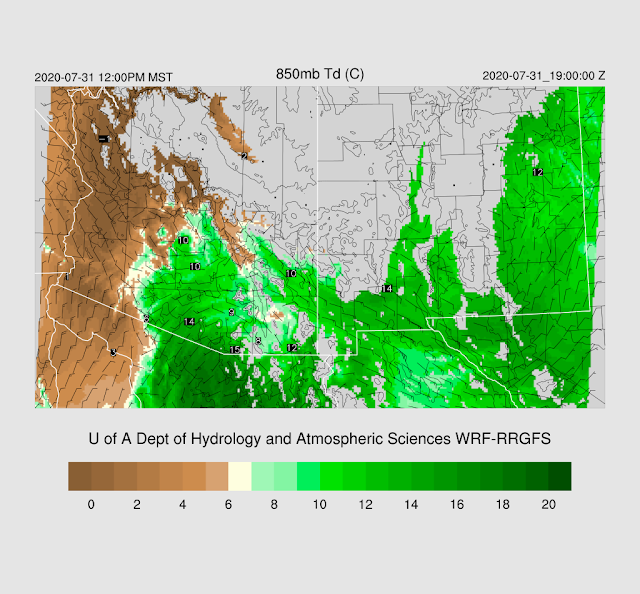As I said on Twitter yesterday, it is always difficult to forecast more than a few days in advance during the monsoon season. When I wrote the last discussion on the 28th, it looked like it was going to be at least a week before significant moisture returned. However, I did see that very moist and high CAPE lurked just across the border for the entire period, with brief intrusions. It turns out that this airmass will move farther into Arizona and give southeastern Arizona a risk of strong to severe storms over the next few days. Surface dewpoints have increased over far southern and southwestern Arizona as Yuma is now 74F, and Nogales is 66F. So far, this moisture is shallow, as GPSIPW has barely moved up, but very moist air is present just to the south.
The 500mb pattern has the strong 500mb anticyclone centered over eastern Arizona, with mainly light east to southeast winds over the state. Slightly cooler 500mb air is over Arizona and NW Mexico as temperates range from -6 to -8C. Cooler air is advecting into NM on northerly flow and a weak jet streak.
Surface high temperatures are again predicted to be near records, this is going to result in some steep lapse rates in the lower 1/2 of the atmosphere. At Phoenix, the old PBL goes all the way to just above 500mb! Westerlies continue to be strong in the upper atmosphere, as they have been all summer.
Initializations
It is a straightforward situation as it's mainly clear over the state and without any significant cyclonic circulations. PW initialization was the best by the 12Z RR, followed by the 6Z GFS. The 6Z NAM was a bit too wet in NM and Sonora, but not too bad. The 12Z NAM isn't too bad over Arizona, but is somewhat too wet in Mexico. The favorites are the RR and GFS.
Day 1
It is shaping up to be an exciting couple of days, at least for southeastern Arizona. Moisture continues to advect into much of southeastern Arizona today from both Sonora and from southern NM. Early afternoon 850mb dewpoint temperatures are as high as 14C over far southern Arizona. The surge is very shallow out in western Arizona as the moisture barely even registers at 850mb.
CAPE also increases and is quite high along the border. Much of NM also has moderate to high CAPE and is primed for a big day. DCAPE is large as ABQ has 1400 J/kg, and EPZ has 1800 J/kg!
Far SE Arizona is right on the boundary of the high CAPE air, and the 6Z runs have the boundary a bit farther west and north and perhaps sufficient for some later activity.
The Nogales forecast Skew-T is quite impressive as there is a lot of CAPE, and steering flow and shear are excellent. Thus I'd say that some strong storms look likely for the border areas of southeastern Arizona this evening.
WRF develops some strong/severe storms just along the border by late afternoon while severe storms, with supercell characteristics, develop over northern and eastern NM. I don't usually mention NM, but what happens there is important for southeastern Arizona's future.
Eventually, the NM storms develop into a broad squall line that moves all the way into southern NM and west Texas after midnight.
As DCAPE is very high, thunderstorm outflows are strong and cover a wide area.
There is some threat of storms developing during the early morning hours over southeastern Arizona due to the convergence provided by the outflow boundary.
Just for fun, here's Yuma's evening Skew-T forecast plot. CAPE is about as large as it gets here in Arizona, but the moist layer is shallow and capped.
Day 2
The strong outflow continues to move across New Mexico and, by 12Z, is entering far southeastern Arizona resulting in an increase in moisture. Also, moist advection continues from northern Sonora.
Hold on to your hats!
Let's look a little closer at the Tucson forecast Skew-T plot. Yes, there is an enormous amount of CAPE. There is also a significant cap at the top of the mixed layer and a strong subsistence inversion at 400mb. The cap is the real problem, and it's going to be hard to break through it.
By late afternoon at Nogales (and elsewhere at higher elevations of SE Arizona), the PBL is mixed to the LCL and is close to breaking the cap. The wind profile is excellent with good mid-level NE flow, lower level shear, and light upper winds. This is one of the most favorable situations for severe storms that I've ever seen in Arizona.
It takes a while for storms do get going, but by late afternoon, intense storms are underway over the higher elevations. Once they get going though, they expand rapidly and quickly become severe.
They generally move to the southwest and remain in Santa Cruz and southern Cochise Counties. It's uncertain exactly where and when this far in advance and I'll have a better idea tomorrow.
As the sub cloud layer is relatively shallow, outflow boundaries aren't as strong as they were in NM the previous day. Are they strong enough to trigger additional convection to the north? Maybe.
Tucson is mixed a bit deeper by this time, and the cap has weakened, so storms could form as the outflow moves through, especially as it's coming in 180 degrees to the low-level flow. Thus low-level convergence is optimal.
The 12Z WRFRR does manage to trigger a few thunderstorms in and around Tucson. Other storms continue over parts of southeastern Arizona.




















No comments:
Post a Comment
Note: Only a member of this blog may post a comment.